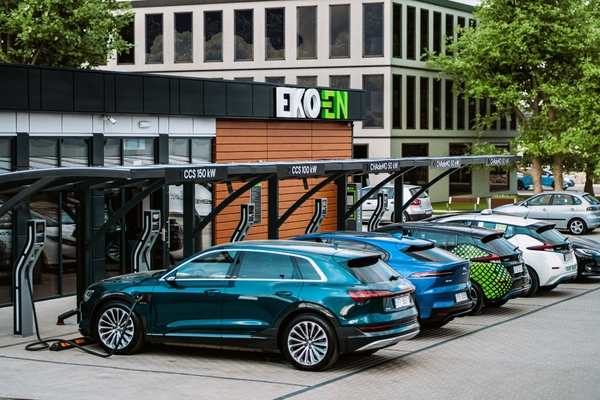In the hustle and bustle of urban life, the rise of electric vehicles (EVs) is no longer a distant vision but a present reality. As of 2023, EV sales have surged by over 40% globally, according to Bloomberg Green, driven by climate goals and sustainable transportation initiatives. A pivotal element in this transformation is the emergence of urban EV charging hubs, which are revolutionizing city transportation. These hubs not only address the growing needs of EV users but also pave the way for a greener, more efficient urban future. In this article, we’ll explore how these charging hubs are reshaping urban landscapes, the technology behind them, and what this means for city dwellers and urban planners alike.
The Rise of Urban EV Charging Hubs
Why Urban Charging Hubs Matter
Urban EV charging hubs are strategically placed stations that provide multiple charging points, catering to the high density of EV traffic in city areas. With reports from Reuters Mobility highlighting that urban areas are responsible for nearly 70% of global carbon emissions, these hubs are instrumental in combating climate change. They offer:
- Convenience: Positioned in high-traffic areas like shopping centers, parking lots, and transit hubs.
- Efficiency: Equipped with fast-charging technology to reduce wait times.
- Accessibility: Designed to accommodate a diverse range of vehicles, from personal cars to electric buses.
Technological Innovations Behind Charging Hubs
Modern urban EV charging hubs are equipped with state-of-the-art technology that enhances their functionality and user experience. According to Wired, advancements in battery technology and charging infrastructure have been pivotal. Key innovations include:
- Ultra-fast Chargers: Capable of delivering 100 miles of range in just 10 minutes, as seen in Tesla’s Superchargers and Hyundai’s Ioniq 5 models.
- Smart Grid Integration: These hubs connect with local power grids to optimize energy use and integrate renewable sources, reducing reliance on fossil fuels.
- Contactless Payment Systems: Allow seamless transactions through mobile apps, reducing the need for physical interaction and speeding up the process.
Transforming Urban Mobility
Impact on City Infrastructure
The implementation of EV charging hubs significantly impacts urban infrastructure. According to InsideEVs, cities like New York and London have begun to redesign their urban planning strategies to incorporate these essential facilities. The benefits include:
- Reduced Traffic Congestion: By strategically placing hubs, cities can manage EV traffic flow more effectively.
- Enhanced Public Transport: Electric buses and taxis benefit from dedicated charging facilities, improving public transport efficiency.
- Urban Aesthetics: Charging hubs are often designed with aesthetics in mind, incorporating green spaces and modern architecture.
Environmental Benefits
The environmental impact of urban EV charging hubs cannot be understated. CleanTechnica reports that these hubs contribute to substantial reductions in greenhouse gas emissions. The shift from gasoline to electric reduces air pollution, leading to:
- Improved Air Quality: Significant reduction in pollutants like NOx and particulate matter.
- Lower Noise Pollution: Electric vehicles are quieter, contributing to a more peaceful urban environment.
- Support for Renewable Energy: By integrating solar panels and wind turbines, charging hubs promote sustainable energy use.
Practical Guide to Urban EV Charging
How to Use Urban Charging Hubs
For EV owners, understanding how to efficiently use urban charging hubs is key. Here are some tips:
- Plan Ahead: Use apps like PlugShare or ChargePoint to locate charging stations and check availability.
- Optimize Charging Time: Charge during off-peak hours when electricity is cheaper and stations are less crowded.
- Membership Benefits: Join loyalty programs offered by charging networks for discounted rates and priority access.
Where to Find the Best Charging Hubs
Several major cities are leading the way in urban EV infrastructure. According to Electrek, some of the best urban charging networks include:
- Los Angeles: Home to numerous fast-charging hubs, supported by Tesla and EVgo.
- Amsterdam: Offers a comprehensive network of public chargers, integrating renewable energy.
- Shanghai: Boasts one of the largest urban charging networks in Asia, accommodating the rise of brands like BYD and NIO.
Conclusion: The Future of Urban Transportation
Urban EV charging hubs are at the forefront of transforming city transportation, offering a sustainable solution to the growing demand for electric vehicles. They not only facilitate the transition to greener cities but also enhance urban living by improving air quality and reducing noise pollution. As technology continues to advance, the potential for even more innovative and efficient charging solutions is on the horizon.
Are you ready to embrace the electric revolution in your city? With urban EV charging hubs becoming more widespread, the future of sustainable urban transportation looks promising. Keep an eye on developments in your area and consider the benefits of switching to an electric vehicle. Together, we can drive towards a cleaner, more sustainable future. What’s your take on the urban EV revolution? Share your thoughts and experiences in the comments below!

